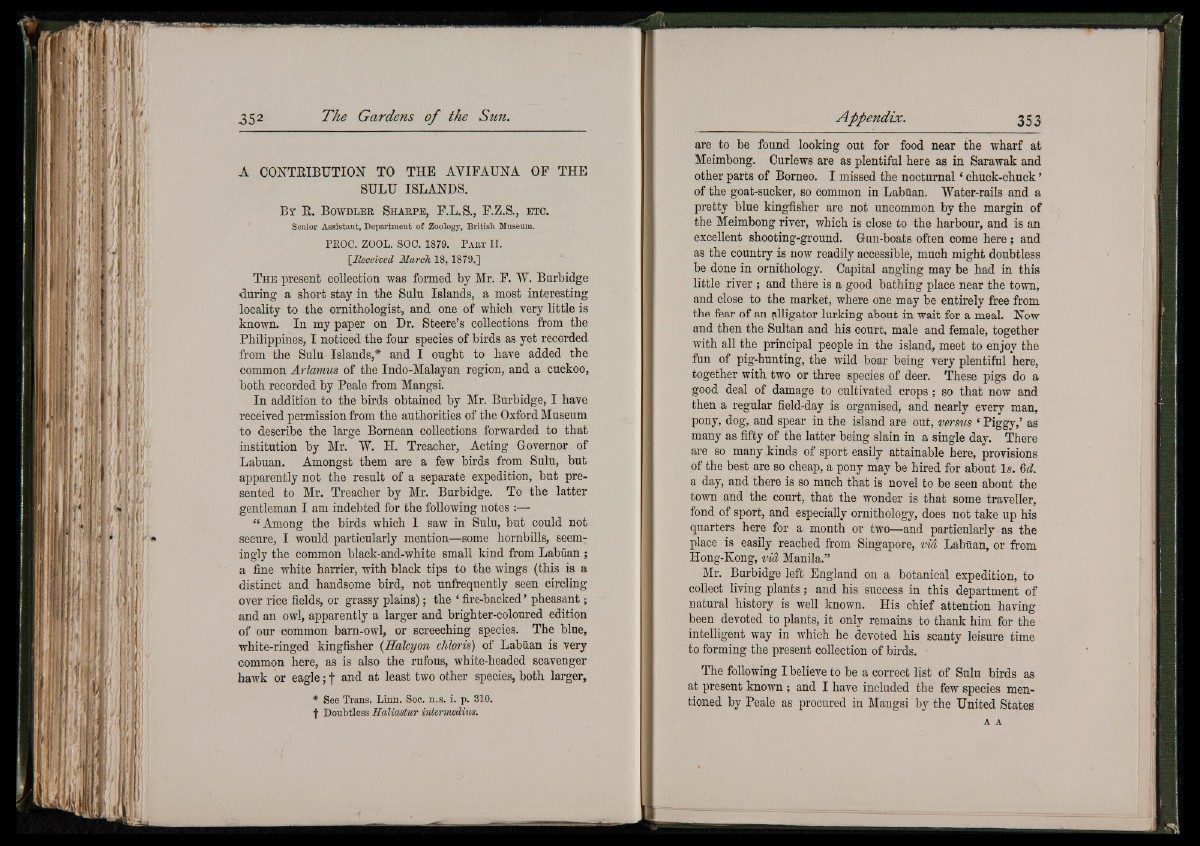
A CONTRIBUTION TO THE AVIFAUNA OF THE
SULU ISLANDS.
B y R. B ow d le e Shaepe, F.L.S., F.Z.S., etc.
S en io r A s s is ta n t, D e p a r tm e n t o f Zo o lo g y , B r it is h M u seum.
PKOC. ZOOL. SOC. 1879. P a k t II.
[Received March 18, 1879.]
The present collection was formed by Mr. F. W. Burbidge
during a short stay in the Sulu Islands, a most interesting
locality to the ornithologist, and one of which very little is
known. In my paper on Dr. Steere’s collections from the
Philippines, I noticed the four species of birds as yet recorded
from the Sulu Islands,* and I ought to have added the
common Artamus of the Indo-Malayan region, and a cuckoo,
both recorded by Peale from Mangsi.
In addition to the birds obtained by Mr. Burbidge, I have
received permission from the authorities of the Oxford Museum
to describe the large Bornean collections forwarded to that
institution by Mr. W. H. Treacher, Acting Governor of
Labuan. Amongst them are a few birds from Sulu, but
apparently not the result of a separate expedition, but presented
to Mr. Treacher by Mr. Burbidge. To the latter
gentleman I am indebted for the following notes :—
“ Among the birds which 1 saw in Sulu, but could not
secure, I would particularly mention—some hornbills, seemingly
the common black-and-white small kind from Labuan ;
a fine white harrier, with black tips to the wings (this is a
distinct and handsome bird, not unfrequently seen circling
over rice fields, or grassy plains); the gfire-backed’ pheasant;
and an owl, apparently a larger and brighter-coloured edition
of our common barn-owl, or screeching species. The blue,
white-ringed kingfisher {Halcyon chloris) of Labuan is very
common here, as is also the rufous, white-headed scavenger
hawk or eagle; f and at least two other species, both larger,
* See Trans. Linn. Soe. n.s. i. p. 310.
f Doubtless Haliastur intermedim.
are to be found looking out for food near the wharf at
Meimbong. Curlews are as plentiful here as in Sarawak and
other parts of Borneo. I missed the nocturnal * chuck-chuck ’
of the goat-sucker, so common in Labuan. Water-rails and a
pretty blue kingfisher are not uncommon by the margin of
the Meimbong river, which is close to the harbour, and is an
excellent shooting-ground. Gun-boats often come here; and
as the country is now readily accessible, much might doubtless
be done in ornithology. Capital angling may be had in this
little river ; and there is a good bathing place near the town,
and close to the market, where one may be entirely free from
the fear of an alligator lurking about in wait for a meal. Now
and then the Sultan and his court, male and female, together
with all the principal people in the island, meet to enjoy the
fun of pig-hunting, the wild boar being very plentiful here,
together with two or three species of deer. These pigs do a
good deal of damage to cultivated crops; so that now and
then a regular field-day is organised, and nearly every man,
pony, dog, and spear in the island are out, versus ‘ Piggy,’ as
many as fifty of the latter being slain in a single day. There
are so many kinds of sport easily attainable here, provisions
of the best are so cheap, a pony may be hired for about Is. 6d.
a day, and there is so much that is novel to be seen about the
town and the court, that the wonder is that some traveller,
fond of sport, and especially ornithology, does not take up his
quarters here for a month or two—and particularly as the
place is easily reached from Singapore, via Labuan, or from
Hong-Kong, vid Manila.”
Mr. Burbidge left England on a botanical expedition, to
collect living plants; and his success in this department of
natural history is well known. His chief attention having
been devoted to plants, it only remains to thank him for the
intelligent way in which he devoted his scanty leisure time
to forming the present collection of birds.
The following I believe to be a correct list of Sulu birds as
at present known ; and I have included the few species mentioned
by Peale as procured in Mangsi by the United States